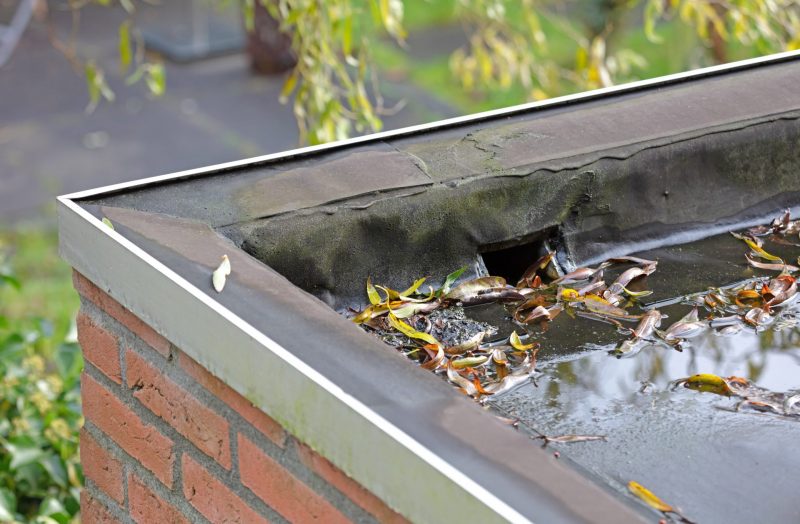Even though flat roofs have been standard in commercial architecture, modern designs for residential buildings are increasingly using them. Therefore, it’s not uncommon for you to find yourself with a flat-roofed home.
One of the reasons for the rise in popularity of flat roofs is their functionality. Besides being more resistant to adverse environmental conditions like strong winds, you can also use it as your relaxing or outdoor living space.
However, despite the multi-functionality that comes with it, a flat roof can pose a few challenges. The main one is its drainage system. Pools of water can accumulate on the roof when it rains, which can cause stress on your roof’s structural support. As a result, the water and other debris can quickly damage your roof, causing costly repairs.
Therefore, installing necessary drains on your roof to direct the water away from it is crucial. Various systems can help you achieve this. For instance, using a gutter system is one of the preferable drain systems by constructors.
Alternatively, you can install a leaf-free gutter system, such as the K-Guard Leaf-Free Gutter System, or ensure you clean up your gutter drains regularly to remove debris. Read below for more details on the gutter system and other effective drains for your flat roof.
Table of Contents
1) Gutter System
As mentioned above, the gutter system is one of the most commonly used drains for a flat roof. Most contractors install gutters as part of the building’s plan. However, if you find your home doesn’t have an efficient roof drain, you can consider installing gutters.
Moreover, construction professionals consider gutters more cost-effective. One of the main reasons is that they don’t need you to carry out extensive roof modification to install them.
On the other hand, most flat roofs aren’t completely flat. Any roof that has an angle of fewer than 10 degrees is considered flat. Therefore, your roof may typically have a slight slope to it. This means when it rains, the rainwater flows by gravity from the roof.
Meanwhile, gutters would aid in directing water flow along the roof’s edges and away from the structure. This helps control its flow towards the central drainage system on the ground level. Thus, you can avoid erosion around your building’s foundation. The gutters also prevent water from splashing on the window and door openings.
If you’re considering the gutter system, it’s essential to know that it would require regular clearing of debris. This is a maintenance process to prevent clogging and increase its lifespan.
2) Internal Drains
Other roofing experts also call these inner or interior drains. As the name indicates, these drains aren’t visible from the outside, unlike gutters or scuppers.
Internal drains are typically installed across the roof and have drain pipes hidden underneath. They lead the water away from the top and towards the primary drainage system on the ground. Each drain connects to its pipeline, which directs the flow of water.
Moreover, internal drains have a screen on the roof flow that prevents debris from entering the drainage system. This helps prevent clogging along the drainage line. Depending on its size, you can install one or more internal drains on your roof. However, it’s recommended to ensure the drains’ placement is strategic to avoid water pools.
Even though this type of drain is slightly more expensive, it can last longer. It’s because they’re protected from adverse weather conditions by the building’s structure.
Additionally, internal drains don’t affect your structure’s visual appeal. However, it’s essential to ensure that no debris gets into the drains. The reason is that if they clog, you may need to get a roofing professional to unclog and repair them.
3) Scuppers
Although they’re almost similar to gutters, their functionality differs. While gutters collect and direct water from the roof, scuppers direct the water from the flat roof. In addition, they aren’t installed on the entire roof’s edge.
On the other hand, it’s important to note that scuppers work best with other drain systems. You can use scuppers with gutters or tapered insulation. Most roof experts recommend tapered insulation as it helps direct water pools toward scuppers.
In addition, scuppers don’t get clogged easily as they’re mainly wide by design. However, they protrude from the building’s wall, hence, they can easily be destroyed by severe weather. Thus, if you live in a location with frequent strong winds or storms, it may not be ideal.
Conclusion
When you have a flat roof home, ensuring an effective drain system is key to avoiding water pools that can be damaging. The various options listed above are the different drains you can use to remove water from your roof effectively. However, it’s essential to consult your local roofing professional to assess your flat roof better.







